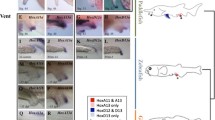Hoxd genes are needed for the formation of sphincters to subdivide the developing gut.
Abstract
As well as their shared role in the anteroposterior patterning of vertebrates1, particular Hox gene com-plexes have evolved specific functions. For example, four consecutive genes of the HoxD cluster contribute to making proper digits2,3. Functional studies of such traits are difficult because there is a high genetic redundancy4, which means that several gene inactivations in cis are needed to analyse these global regulations. We have used a HoxD mini-complex in mice to show that an overlapping, yet different, set of Hoxd genes contributes to the formation of a major anatomical and physiological subdivision of the gut, the ileocaecal sphincter, which divides the small intestine from the large bowel.

Similar content being viewed by others
References
Krumlauf, R. Cell 78, 191–201 ( 1994).
Dollé, P. et al. Nature 342, 767–772 (1989).
van der Hoeven, F. et al. Cell 85, 1025–1035 (1996).
Rijli, F. & Chambon, P. Curr. Opin. Gen. Dev. 7, 481–487 (1997).
Condie, B. G. & Capecchi, M. R. Development 119, 579–595 (1993).
Izpisúa-Belmonte, J. C. et al. Development 110, 733–746 (1991).
Dollé, P. & Duboule, D. EMBO J. 8, 1509–1515 (1989).
Gérard, M., Duboule, D. & Zákány, J. EMBO J. 12, 3539 –3550 (1993).
Zákány, J. & Duboule, D. Nature 384 69–71 (1996).
Kondo, T. et al. Development 122 2651– 2659 (1996).
Roberts, D. J. et al. Development 121, 3163– 3174 (1995).
Sekimoto, T. et al. Genes Cells 3, 51– 64 (1998).
Bienz, M. Trends Genet. 10, 22–26 (1994).
Author information
Authors and Affiliations
Corresponding author
Rights and permissions
About this article
Cite this article
Zákány, J., Duboule, D. Hox genes and the making of sphincters. Nature 401, 761–762 (1999). https://doi.org/10.1038/44511
Issue Date:
DOI: https://doi.org/10.1038/44511
- Springer Nature Limited
This article is cited by
-
Patterning of anteroposterior body axis displayed in the expression of Hox genes in sea cucumber Apostichopus japonicus
Development Genes and Evolution (2015)
-
Toward simpler and faster genome-wide mutagenesis in mice
Nature Genetics (2007)
-
Molecular Insights into Congenital Disorders of the Digestive System
Pediatric and Developmental Pathology (2003)
-
Targeted inversion of a polar silencer within the HoxD complex re-allocates domains of enhancer sharing
Nature Genetics (2000)
-
BMP signalling specifies the pyloric sphincter
Nature (1999)





